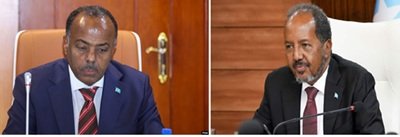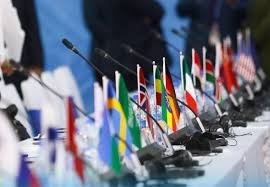By Isha Qarsoon
On 10 June 2025, Somalia’s State Minister for Foreign Affairs and International Cooperation, Ali Omar, issued a formal letter to James Swan, the United Nations Secretary-General’s Special Representative for Somalia and head of the United Nations Transitional Assistance Mission in Somalia. The letter was clear, assertive, and diplomatically firm: the so-called “C6+ framework,” a structure used to coordinate international support and engagement with Somalia’s transitional institutions, was now, in the government’s view, obsolete. The letter called for a clean break with the past and urged the international community to end the use of C6+ mechanisms in favor of bilateral or mutually respectful multilateral partnerships.
At first glance, the timing of the letter may seem curious. After all, James Swan’s last major public endorsement of the C6+ coordination framework came nearly a year earlier, in his June 2024 address to the United Nations Security Council. In that speech, Swan stated, “The transition… is in line with the request of the Federal Government of Somalia… The C6+ coordination platform will remain central to ensuring a coherent international engagement during this process.” While Swan acknowledged Somalia’s request for mission transition, his insistence on the continued role of the C6+ suggested a perception that Somalia remained a state in need of oversight and structured donor alignment.
What explains the delay in response? The answer lies not in any one speech, but in the accumulation of diplomatic and operational actions throughout late 2024 and early 2025. United Nations reports and outreach continued to invoke the C6+ framework as central to the transition mission and donor engagement. For instance, a consultative workshop in January 2025 reaffirmed the roadmap for a successor cooperation framework based on inherited coordination platforms. Press statements from United Nations agencies throughout early 2025—including those relating to human rights visits and security coordination—continued to describe Somalia’s development through the lens of international alignment, rather than sovereign-led governance.

The government’s argument is not without appeal. It asserts that Somalia has moved beyond the need for transitional scaffolding. Under the leadership of President Hassan Sheikh Mohamud, the state claims to have established functioning democratic institutions, charted a national development course, and rebuilt its capacity to engage in international diplomacy as an equal. Yet, beneath the rhetoric lies a more troubling reality: Somalia’s recent legal and political trajectory tells a story not of sovereignty reclaimed, but of constitutional evasion, power consolidation, and institutional erosion.
Historically, the C6+ framework took shape over years of post-conflict engagement. It evolved from earlier coordination structures established by Somalia’s international partners during a period when the country’s institutions were severely weakened and unable to function independently. Its most visible operational form coalesced around the New Deal Compact signed in 2013, which sought to stabilize Somalia through aligned donor support, inclusive governance benchmarks, and transitional aid management. The framework offered a way to harmonize international assistance with national priorities, albeit under conditions shaped largely by donor interests. Though imperfect, it brought coherence to Somalia’s fragmented political and financial landscape at a time when the state lacked control over much of its territory.
Over time, however, the rationale for maintaining this model diminished. Somalia’s institutions, though fragile, began to reassert themselves. Indirect elections were held, federal member states gained clearer administrative roles, and national development strategies became more prominent. By the time UNSOM transitioned into the United Nations Transitional Assistance Mission in 2024, Somali authorities had already signaled their desire for greater ownership over policy and aid processes. Nonetheless, international actors—particularly the United Nations—continued to subtly invoke the C6+ framework in their engagements, reinforcing a perception that Somalia remained locked in a transitional phase. That perception has increasingly clashed with the Somali government’s aspiration to be treated as a sovereign equal.
The Somali government’s letter is, in part, a response to this lingering disconnect or disrespect. It is an attempt to reclaim narrative control and assert that Somalia is no longer a laboratory for externally led experiments. In that sense, the letter is both symbolically and politically important. It draws a line between the past and the future, between donor dependency and diplomatic parity. However, symbols cannot substitute for substance. Sovereignty is not merely a diplomatic posture; it is a legal condition, rooted in the rule of law and the legitimacy of national institutions. And it is here that Somalia’s claim to full sovereign status begins to fray.
Consider first the government’s recent electoral legislation. In 2023 and 2024, the federal executive pushed through a new electoral law that fundamentally altered Somalia’s electoral system. Rather than preserving the balance between federal and state authority envisaged by the Provisional Constitution, the law centralized control over elections in the hands of the federal government. It marginalized federal member states and concentrated procedural authority in federal institutions, effectively dismantling the cooperative federalism that the Provisional Constitution prescribes. This was done with minimal consultation and absent judicial review—circumstances that raise serious concerns about legality and legitimacy.
This pattern extends to constitutional amendments as well. In 2024, the government announced key constitutional changes aimed at strengthening the executive, restructuring political parties, and modifying the electoral framework. Yet, these amendments were enacted without the judicial and procedural safeguards required by the Provisional Constitution. There is no functioning federal courts or judicial Service Commission, no operational National Constitutional Commission, and no credible legislative oversight of the amendment process. What results is a situation in which constitutional change is driven not by law, but by political fiat.
Compounding this institutional regression is a broader governance failure. Somalia’s public institutions remain underdeveloped and poorly coordinated. Basic services such as education, healthcare, and infrastructure are dysfunctional or absent. Flooding continues to devastate urban and rural communities alike, with no effective mitigation in place. Security agencies, including the police and NISA, frequently face accusations of abuse, extortion, and excessive force. The state’s ability to deliver for its citizens remains weak, undermining public trust and reinforcing the need for oversight and reform.
In this context, the government’s rejection of the C6+ framework, while rhetorically compelling, loses its moral clarity. The argument becomes less about sovereignty and more about insulation—about removing international oversight at a time when the government is centralizing power, bypassing constitutional constraints, and silencing dissent. The danger here is not that Somalia asserts sovereignty, but that it does so while hollowing out the institutions that make sovereignty meaningful.
James Swan and the United Nations, for their part, have not been faultless. The continued use of C6+ language, even as Somalia has moved into new political territory, reflects a failure to recalibrate diplomatic messaging. Public references to outdated frameworks risk reinforcing the very dependency narratives the Somali government seeks to shed. More importantly, they create space for governments to deflect criticism by accusing the international community of neocolonial overreach. Swan’s June 2024 remarks, though likely routine from a mission management perspective, failed to anticipate their symbolic weight in a charged political climate.
Still, the deeper problem lies not with language, but with legality. If the federal government of Somalia wants to be treated as a mature sovereign partner, it must behave like one. That means more than issuing assertive letters or rejecting donor frameworks. It requires a commitment to constitutionalism, to judicial oversight, to political pluralism, and to transparent governance. Without these, sovereignty becomes a rhetorical shell—form without content, power without legitimacy.
The United Nations and other international partners must also adapt. They should drop the language of C6+ and reorient their support toward frameworks that are negotiated with and led by Somali institutions. But they must not confuse diplomacy with deference. Support should be conditioned not on the absence of coordination platforms, but on the presence of legitimate, participatory, and constitutional governance. If Somalia refuses oversight but subverts the constitution to deliver “elected” authoritarianism, the international community has a responsibility to call that what it is. Few documents in recent Somali diplomacy have carried the symbolic weight of the 10 June 2025 letter. It marks a desire to close the chapter of post-conflict transition and to embrace a future of sovereign partnership. That aspiration deserves recognition. But sovereignty must be earned—not just claimed. It must be grounded in law, practiced with restraint, and legitimated through the consent of the governed. Until the federal government of Somalia can meet those standards, its rejection of the C6+ framework remains more a perform.
Isha Qarsoon
Email: Ishaqarsoon1@gmail.com
——-
Isha Qarsoon- is a platform dedicated to addressing critical issues pertaining to good governance, corruption, and social challenges. It emphasizes investigative journalism as a means to uncover and disseminate information, enabling the public to engage with and understand the realities of the country. Through its focus on transparency and accountability, the forum aims to foster informed public discourse and contribute to societal awareness and reform.
________________
Related articles:
Echoes of Farmaajo: President Hassan Breaks with C6+ Amid Political Discontent and Election Disputes By WardheerNews
Somalia on the edge: Downgrading C6+ risks collapse By Abdullahi A Nor


Leave a Reply